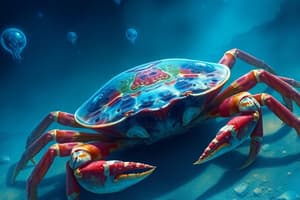Podcast
Questions and Answers
What is the primary habitat of horseshoe crabs?
What is the primary habitat of horseshoe crabs?
- Wetlands
- Saltwater oceans (correct)
- Freshwater lakes
- Mountain streams
How long have horseshoe crabs existed?
How long have horseshoe crabs existed?
- 200 million years
- 150 million years
- 300 million years (correct)
- 400 million years
Which of the following is NOT a species of horseshoe crab mentioned?
Which of the following is NOT a species of horseshoe crab mentioned?
- Chinese horseshoe crab
- Mangrove horseshoe crab
- Pacific horseshoe crab (correct)
- Atlantic horseshoe crab
At what depth can adult horseshoe crabs typically be found?
At what depth can adult horseshoe crabs typically be found?
What is the primary reason juvenile horseshoe crabs inhabit shallower waters?
What is the primary reason juvenile horseshoe crabs inhabit shallower waters?
What do horseshoe crabs primarily do while they are on the ocean floor?
What do horseshoe crabs primarily do while they are on the ocean floor?
Which horseshoe crab species is primarily found along the Gulf and eastern Atlantic coasts of the United States?
Which horseshoe crab species is primarily found along the Gulf and eastern Atlantic coasts of the United States?
What type of animal are horseshoe crabs most closely related to?
What type of animal are horseshoe crabs most closely related to?
Where do horseshoe crabs lay their eggs?
Where do horseshoe crabs lay their eggs?
Which of the following regions is NOT home to any species of horseshoe crabs?
Which of the following regions is NOT home to any species of horseshoe crabs?
What characteristic of horseshoe crabs distinguishes them from true crabs?
What characteristic of horseshoe crabs distinguishes them from true crabs?
Which of the following habitats do juvenile horseshoe crabs prefer?
Which of the following habitats do juvenile horseshoe crabs prefer?
What depth range can adult horseshoe crabs typically be found in?
What depth range can adult horseshoe crabs typically be found in?
How do horseshoe crabs primarily move along the ocean bottom?
How do horseshoe crabs primarily move along the ocean bottom?
Which species of horseshoe crab is NOT found in the Atlantic Ocean?
Which species of horseshoe crab is NOT found in the Atlantic Ocean?
What is a common ancestor trait of horseshoe crabs and spiders?
What is a common ancestor trait of horseshoe crabs and spiders?
Where do horseshoe crabs lay their eggs to protect them from predators?
Where do horseshoe crabs lay their eggs to protect them from predators?
Which of the following statements about horseshoe crab species is true?
Which of the following statements about horseshoe crab species is true?
What is a key survival advantage for horseshoe crabs during their juvenile stage?
What is a key survival advantage for horseshoe crabs during their juvenile stage?
When did horseshoe crabs first appear on Earth?
When did horseshoe crabs first appear on Earth?
Flashcards are hidden until you start studying
Study Notes
Horseshoe Crabs
- Horseshoe crabs are marine invertebrates with eight legs and a hard exoskeleton, more closely related to spiders than crabs.
- They have remained largely unchanged for over 300 million years, predating dinosaurs.
- Four species exist: Atlantic, Mangrove, Coastal, and Chinese.
- Horseshoe crabs are found in salt water along coastlines, with egg-laying occurring on sandy beaches for protection.
- Juvenile horseshoe crabs inhabit shallow, protected areas like estuaries for the first two years.
- Adults are found in depths ranging from 100 to over 600 feet, spending most of their time on the sandy ocean floor.
- They can swim, but primarily walk along the ocean floor, where their food sources are located.
- The Atlantic horseshoe crab is found on the Gulf and Eastern Atlantic coasts of the United States, from Texas to Maine.
- The Mangrove and Coastal horseshoe crabs inhabit the Indian and Pacific Oceans, along the coasts of Southeast Asian countries.
- The Chinese horseshoe crab is found in the Eastern Pacific Ocean, along the coasts of East and Southeast Asia.
- Horseshoe crabs are omnivores, feeding primarily on worms and mollusks, particularly clams.
- They use their small front claws to grab food and move it to their mouth, which is equipped with bristles and plates for crushing and chewing.
- Horseshoe crabs utilize bristly plates in the center of their body for feeding.
Horseshoe Crabs - Ancient Relatives of Spiders
-
Oldest Living Species: Horseshoe crabs have remained basically the same for around 300 million years, predating dinosaurs.
-
Physical Characteristics: Marine animals with eight legs, a hard shell, and a body structure related to spiders.
-
Distribution: Found in Atlantic, Indian, and Pacific Oceans, with four different species.
Habitat and Lifestyle
-
Marine Life: They inhabit salt water, ranging from coastal beaches to depths over 600 feet.
-
Life Cycle: Horseshoe crab eggs are laid on sandy beaches for protection. Juveniles live in shallow, protected areas like estuaries until maturity. Adults can live in deeper water, spending most of their time on the ocean floor.
-
Movement: They are primarily bottom-dwellers, walking along the sandy floor where they find food. They can swim but usually prefer walking to keep their hard upper shell protected.
Species and Locations
-
Atlantic Horseshoe Crab (Limulus polyphemus): Found along the Gulf and eastern Atlantic coasts of the United States, from Texas to Maine.
-
Mangrove Horseshoe Crab (Carcinoscorpius rotundicauda) and Coastal Horseshoe Crab (Tachypleus gigas): Similar geographic ranges in the Indian and Pacific Oceans, along the coasts of India, Indonesia, Malaysia, Singapore, and the Philippines.
-
Chinese Horseshoe Crab (Tachypleus tridentatus): Found in the eastern Pacific Ocean, along the coasts of China, Japan, Taiwan, Malaysia, South Korea, Vietnam, and the Philippines.
Diet
-
Ocean Floor Scavengers: Horseshoe crabs primarily feed on worms and mollusks, with clams being a common source.
-
Feeding Mechanism: They grab food with front claws, transport it to their mouth, crush it with hard plates, and use bristly plates to "chew" it before sending it to their stomach.
Studying That Suits You
Use AI to generate personalized quizzes and flashcards to suit your learning preferences.



